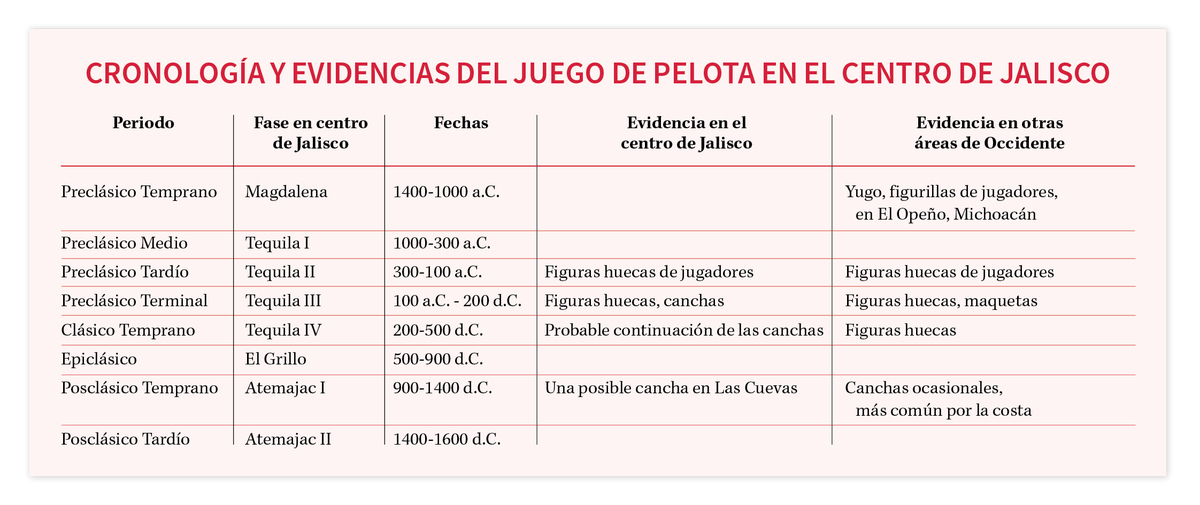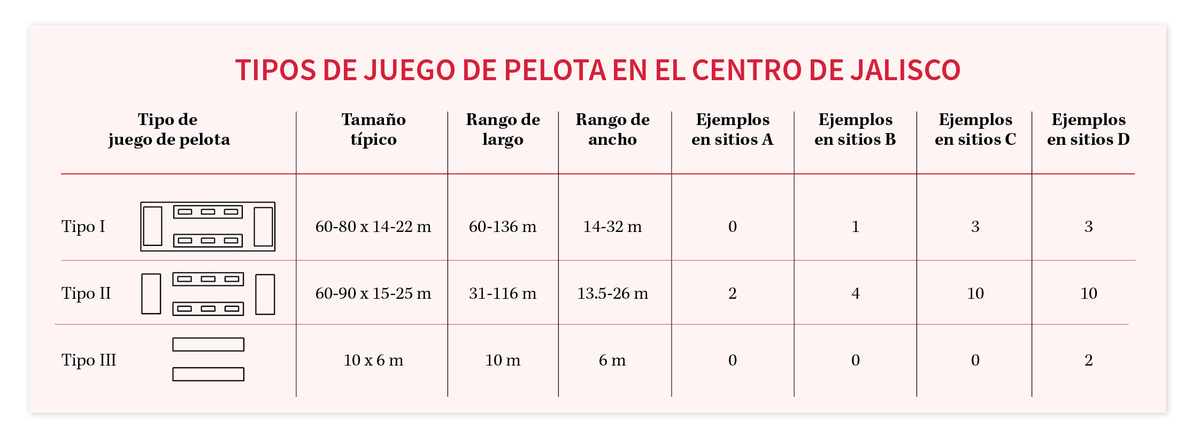

Anderson, David S, “The Origins of the Mesoamerican Ballgame: A New Perspective from the Northern Maya Lowlands”, en Geoffrey Braswell (ed.), The Ancient Maya of Mexico: Reinterpreting the Past of the Northern Maya Lowlands, Equinox, Sheffield, 2012, pp. 43-64.
Beekman, Christopher S., “Fruitful Symmetry: Corn and Cosmology in the Public Architecture of Late Formative and Early Classic Jalisco”, Mesoamerican Voices, 1, 2003, pp. 5-22.
––––––, Corporate Power Strategies in the Late Formative to Early Classic Tequila valleys of central Jalisco”, Latin American Antiquity, 19, 2008, pp. 414-434.
––––––, “Built Space as Political Fields: Community vs. Lineage Strategies in the Tequila Valleys, en Lane Fargher y Verenice Y. Heredia Espinoza (eds.), Alternative Pathways to Complexity: A Collection of Essays on Architecture, Economics, Power, and Cross-Cultural Analysis, University Press of Colorado, Boulder, 2016, pp. 59-78.
––––––, “La secuencia cronológica temprana en Los Guachimontones”, en Joshua D. Englehardt y Verenice Y. Heredia Espinoza, Nuevos enfoques en la arqueología de la región de Tequila: Memoria de la Primera Cátedra Phil C. Weigand, Colegio de Michoacán, Zamora, en prensa.
Beekman, Christopher S., y Phil C. Weigand, “Conclusiones, cronología, y un intento de síntesis, en Phil C. Weigand, Christopher Beekman y Rodrigo Esparza (eds.), Tradición Teuchitlán, Colegio de Michoacán, Zamora, México, 2008, pp. 303-337.
Blanco Morales, Ericka S., “El juego de pelota en la tradición Teuchitlán: Hacia una propuesta sobre su función social”, tesis de maestría, Departamento de Arqueología, Colegio de Michoacán, Zamora, 2009.
Blanco Morales, Ericka S., “Excavaciones Juego de Pelota 2. Temporada 2008-2010. Informe interno”, Proyecto Arqueológico Teuchitlán, 2010.
Butterwick, Kristi, Heritage of Power. Ancient Sculpture from West Mexico. The Andrall E. Pearson Family Collection, Metropolitan Museum of Art, Yale University Press, New Haven, 2005.
Cabrero G., María Teresa, Civilización en el norte de México. Arqueología de la Cañada del Rio Bolaños (Zacatecas y Jalisco), unam, México, 1989.
Cabrero G., María Teresa, y Carlos López C., Civilización en el norte de México, vol. II, unam, México, 2002.
Cohodas, Marvin, The Symbolism and Ritual Function of the Middle Classic Ballgame in Mesoamerica, American Indian Quarterly, 2, 1975, pp. 99-130.
Conabio, 2016, “Castilla elastica”, http://www.conabio.gob.mx/conocimiento/info_especies/arboles/doctos/48-m..., consultado el 3 de septiembre, 2016.
Day, Jane Stevenson, “The West Mexican Ballgame”, en Richard F. Townsend (ed.), Ancient West Mexico. Art and Archaeology of the Unknown Past, Art Institute of Chicago, 1998, pp. 151-167.
DuVall, Shina, “Shared symbolism in powerful places: Cosmological principles displayed through the ceremonial public architecture of the Teuchitlán Tradition in the Tequila valleys of Jalisco, West Mexico”, tesis de maestría, Departamento de Antropología, University of Colorado, Denver, 2007.
Esparza, Rodrigo, y Phil C. Weigand, “Informe técnico temporada 2004-2006”, sitio arqueológico Loma Alta, 2008.
Filloy Nadal, Laura, “Rubber and Rubber Balls in Mesoamerica”, en E. Michael Whittington (ed.), The Sport of Life and Death: The Mesoamerican Ballgame, Thames and Hudson, Londres, 2001, pp. 20-29.
Fox, John Gerald, “Playing with Power: Ballcourts and Political Ritual in Southern Mesoamerica”, Current Anthropology, 37, 1996, pp. 483-509.
Galván Villegas, Luis Javier, Las tumbas de tiro del Valle de Atemajac, inah, México, 1991.
Gillespie, Susan D., “Ball games and Boundaries”, en Vernon Scarborough y David Wilcox (eds.), The Mesoamerican Ballgame, University of Arizona, Tucson, 1991, pp. 317-345.
Hall, Harvey M., y Frances L. Long, Rubber-Content of North American Plants, Carnegie Institution of Washington, Publicación núm. 313, Washington, D.C., 1921.
Heredia Espinoza, Verenice Y., “Long-term Regional Landscape Change in the Northern Tequila Region of Jalisco, Mexico”, Journal of Field Archaeology, en prensa.
Hill, Warren D., Michael Blake y John E. Clark, “Ball Court Design Dates Back 3400 Years”, Nature, 392, 1998, pp. 878-879.
Hill, Warren D., y John E. Clark, “Sports, Gambling, and Government: America's First Social Compact?”, American Anthropologist, 103, 2001, pp. 331-345.
Kowalewski, Stephen A., Gary M. Feinman, Laura Finsten y Richard E. Blanton, “Pre-Hispanic Ballcourts from the Valley of Oaxaca, Mexico”, en Vernon L. Scarborough y David R. Wilcox (eds.), The Mesoamerican Ballgame, University of Arizona Press, Tucson, 1991, pp. 25-46.
Oliveros Morales, José Arturo, Hacedores de tumbas, Colegio de Michoacán, Zamora, México, 2004.
Ortiz, Ponciano, y María del Carmen Rodríguez, “Proyecto Manatí”, Arqueología, 1, 1989, pp. 23-52.
Ramos de la Vega, Jorge, y Lorenza López Mestas, “Datos preliminares sobre el descubrimiento de una tumba de tiro en el sitio de Huitzilapa, Jalisco”, Ancient Mesoamerica, 7, 1996, pp. 121-134.
Stoll, Marijke, y David S. Anderson, “Sport and Ritual as Social Bonding: The Communal Nature of Mesoamerican Ballgames”, en Barbara Voorhies (ed.), Prehistoric Games of the North American Indians: Subarctic to Mesoamerica, University of Utah Press, Salt Lake City, 2017, pp. 447-482.
Taladoire, Eric, 1998, “Los juegos de pelota en el occidente de México”, en Ricardo Ávila, Jean P. Emphoux, Luis G. Gastélum, Susana Ramírez, Otto Schöndube y Francisco Valdez (eds.), El occidente de México: Arqueología, historia y medio ambiente, Universidad de Guadalajara/Instituto Francés de Investigación Científica para el Desarrollo en Cooperación, Guadalajara, pp. 175-187.
––––––, “The Architectural Background of the Pre-Hispanic Ballgame: An Evolutionary Perspective”, en E. Michael Whittington (ed.), The Sport of Life and Death: The Mesoamerican Ballgame, Thames and Hudson, Londres, 2001, pp. 97-114.
––––––, “Cinco tesis discutibles relativas al juego de pelota”, Arqueología, 50, 2015, pp. 191-209.
Tarkanian, Michael J., y Dorothy Hosler, “An Ancient Tradition Continued: Modern Rubber Processing in Mexico”, en E. Michael Whittington (ed.), The Sport of Life and Death: The Mesoamerican Ballgame, Thames and Hudson, Londres, 2001, pp. 116-120.
Weigand, Phil C., “The Western Mesoamerican Tlachco: A Two-Thousand-Year Perspective”, en Vernon L. Scarborough y David R. Wilcox, The Mesoamerican Ballgame, University of Arizona Press, Tucson, 1991, pp. 73-86,
–––––––, “El juego de pelota prehispánico y las canchas de pelota de Jalisco y Nayarit: La tradición de Teuchitlán”, en María Teresa Uriarte (ed.), El juego de pelota en Mesoamérica. Raíces y supervivencia, Siglo Veintiuno, México, 1992, pp. 237-263.
Weigand, Phil C., y Christopher S. Beekman, “La tradición Teuchitlán: Surgimiento de una sociedad parecida al Estado”, en Richard F. Townsend (ed. gral.), y Carlos Eduardo Gutiérrez Arce (ed. de lengua española), El antiguo Occidente de México: Arte y arqueología de un pasado desconocido, Art Institute of Chicago/Secretaría de Cultura del Estado de Jalisco/Tequila Sauza, Artes Gráficas Panorama, Guadalajara, México, 2000, pp. 38-55.
Weigand, Phil C., Efraín Cárdenas García, Acelia García de Weigand y Eugenia Fernández-Villanueva, “Primer Informe del Proyecto Arqueológico Los Guachimontones de Teuchitlán. Estudio de superficie, aeromapificación, aerofotografía, delimitación y excavaciones”, 1999.
Weigand, Phil C. , y Acelia García de Weigand, “Segundo Informe del Proyecto Arqueológico Los Guachimontones de Teuchitlán, Jalisco, temporada de 2000, estudio de excavaciones en los círculos 4, 2 y 1; los Juego de Pelota 1 y 2; y ER-1, 2 y 3”, 2000.
––––––,“Tercer informe al inah. Excavaciones de Los Guachimontones de Teuchitlán, Jalisco, tercera temporada: 2001-2002”, 2002.
